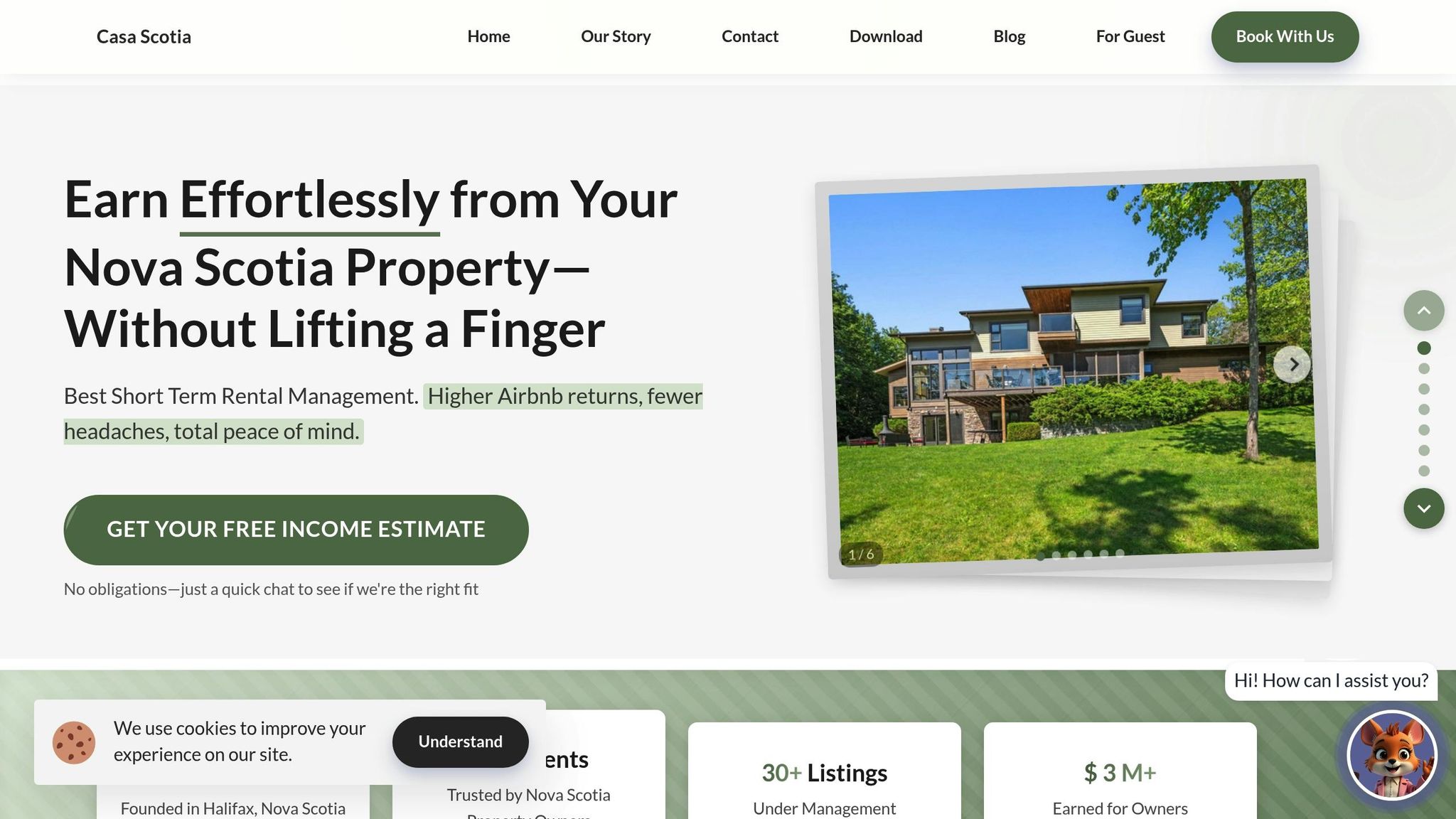Pet-friendly rentals are in high demand in Nova Scotia, with over 60% of Canadian households owning pets and 70% considering them family. Allowing pets can increase bookings, attract loyal guests, and justify premium pricing. However, successful pet-friendly rentals require clear policies to protect your property and ensure guest satisfaction.
Key takeaways:
- Legal Compliance: Nova Scotia landlords can enforce "no pets" clauses, except for service animals. Pet fees must be part of standard rental pricing.
- Clear Rules: Define pet types, size limits, and behavioural expectations. Include these in written agreements and share them with guests at every stage.
- Damage Protection: Charge fair pet fees, document property condition, and consider requiring renters insurance for added security.
- Pet-Safe Adjustments: Use durable materials like vinyl or tile, and provide pet-friendly amenities like outdoor spaces or cleaning tools.
- Marketing: Highlight pet-friendly features in your listing, mention nearby parks, and encourage positive reviews from pet owners.
While pets can bring risks like noise, damage, and cleaning costs, these can be managed with proper preparation. Done right, pet-friendly policies can boost revenue and attract repeat guests.
Pet-Friendly Rentals = Better Tenants. Here’s Why.
Nova Scotia Pet Policy Laws You Need to Know
Understanding Nova Scotia's legal guidelines is essential for protecting your rental property while accommodating pets.
What Nova Scotia's Residential Tenancies Act Says About Pets
In Nova Scotia, landlords have the right to decide whether pets are allowed in their rentals. If a rental agreement includes a "no pets" clause, it is legally enforceable [2][3].
However, there’s an important exception: service animals. Under Canadian human rights laws, including those in Nova Scotia, service animals are exempt from pet restrictions and additional fees [2][3]. This means you cannot deny a booking or charge extra fees for a legitimate service animal.
When it comes to pet fees, Nova Scotia law prohibits landlords from charging an additional deposit specifically for pets [2][3]. Any costs related to pets must be factored into your standard rental pricing.
To ensure clarity and compliance, it’s crucial to formalize your pet policies in writing.
Why You Need Written Pet Agreements
A written pet agreement helps clarify expectations and responsibilities for both parties. It can outline specific rules about the types of pets allowed, their size, breed, and behaviour.
Your agreement should also address practical details, such as whether pets are allowed on furniture, where they can sleep, and how damages will be handled. Including these terms in your rental agreement protects you legally if any disputes arise.
Extra Rules for Condo Properties
If your rental is located in a condominium, additional rules may apply. Condo corporations in Nova Scotia have their own governing documents and bylaws, which can impose stricter pet policies than provincial tenancy laws [3].
These bylaws might outright prohibit pets or restrict certain breeds, sizes, or numbers of animals. In such cases, the condo’s rules take precedence over your rental policies. For short-term rental owners, this means you must review your condo’s declaration, bylaws, and rules before advertising your property as pet-friendly [3].
Even if provincial law allows pets, your condo building may have its own restrictions. To avoid conflicts, consult both Nova Scotia’s tenancy laws and your condo’s governing documents before accepting pet bookings. Some buildings may have outright bans, while others impose more specific limitations [3].
How to Write Clear Pet Rules
Creating clear pet rules is all about setting expectations for guests and their furry companions. When your policies are too vague, misunderstandings can arise. But with detailed guidelines, you can ensure everyone’s on the same page while safeguarding your property.
Setting Pet Limits and Requirements
Be specific about the types of pets you allow - usually cats and dogs - and whether there are size or weight restrictions. Don’t forget to mention the maximum number of pets per booking. It’s also a good idea to require guests to provide proof of vaccinations and spaying or neutering.
If your condo board or insurance policy has restrictions, make those clear upfront. Focus on behaviour-based rules too, like prohibiting pets that show aggressive tendencies or cause damage. These details lay the groundwork for smooth communication throughout the booking process.
Where to Put Your Pet Rules
Your pet rules should be easy to find at every stage of the booking process. Post the main points in your online listing so potential guests know what to expect. Then, include more detailed rules in the booking confirmation email and keep a printed copy at the property in an obvious spot.
This not only reinforces your policies but also gives you a chance to share helpful extras, like contact info for local vets or pet supply shops.
Rules for Pet Behaviour and Cleanup
Once you’ve set clear limits and shared your rules in the right places, spell out behavioural expectations to protect your space. For example, require guests to clean up after their pets using designated methods. If you have shared or multi-unit spaces, establish quiet hours and restrict pets from certain areas. Make it clear that pets shouldn’t be left alone for long periods.
You might also want to add rules about grooming. For instance, ask guests to wipe their pets’ paws before coming inside. To encourage compliance, explain any penalties for breaking the rules, like extra cleaning fees.
Pet Fees and Damage Protection
It’s important to establish fee structures and damage protocols that protect your property while staying fair to pet owners. The goal is to cover any extra cleaning or repair costs without discouraging guests from booking.
How to Set Fair Pet Fees
When setting pet fees, aim to account for additional expenses like cleaning and maintenance. Decide whether a per-pet fee or a flat rate works better for your property, and make sure the fees cover potential added costs. Be upfront about your fee structure before guests book, so there are no surprises.
To safeguard your property, establish clear rules for handling pet-related damage.
Making Guests Pay for Pet Damage
Requiring a pet deposit is a smart way to cover accidental damage. For minor issues, your standard deposit might be enough, but high-end properties with premium furnishings may need extra protection. Define what qualifies as pet damage - such as scratched floors or chewed furniture - in your rental agreement. Take photos of the property before and after each stay to document its condition, which can help if you need to make a claim.
Consider asking guests to provide renters insurance, as their personal liability coverage might cover some types of pet-related damage [4][5]. If the damage exceeds the deposit, you can seek additional compensation by presenting detailed receipts for repairs or cleaning.
Once your damage protocols are in place, ensure all fees are clearly displayed in Canadian dollars.
Showing Fees in Canadian Dollars
List all pet fees in CA$ for clarity, such as "CA$50 per pet per stay." Avoid vague wording like "additional charges may apply" and instead use straightforward language, like "CA$30 cleaning fee." Make sure these fees are easy to find in your property description and booking confirmation emails. Also, explain what the fees include - whether it’s extra cleaning, wear and tear, or special amenities. Consistently clear pricing across all platforms helps build trust and sets the right expectations for your guests.
sbb-itb-b5e1074
Making Your Property Pet‑Safe
Creating a pet-friendly space doesn't just protect your property from wear and tear - it also ensures a welcoming environment for everyone. Here's a closer look at the materials and tools that can help you maintain a pet-safe property.
Choosing Pet‑Resistant Materials
The type of flooring you choose can make a huge difference when it comes to preventing damage caused by pets. Durable options like vinyl planks, wood laminate, tile, and bamboo are excellent choices. These materials resist scratches and odours much better than carpet, which tends to show wear from pet nails and can trap unpleasant smells. If you're dealing with persistent pet odours, consider treating subfloors with products like Nature's Miracle or Kilz. These solutions not only tackle lingering smells but also help prevent future issues [7].
Adding Pet Amenities
Enhancing your property with pet-friendly features can go a long way in keeping both pets and their owners happy. For example, providing designated areas for pets to play or relax can minimize wear and tear in other parts of the property. While specific amenities aren't listed here, think about simple additions like outdoor spaces or easy-to-clean areas that cater to pet needs.
Tools to Prevent Pet Damage
Beyond choosing the right materials, having the right tools can save you time and effort. For outdoor spaces, installing fake grass or turf is a smart way to prevent dogs from digging while making waste cleanup much easier [6]. Indoors, a blacklight can be a game-changer during cleaning inspections. It reveals hidden pet stains that aren't visible under normal lighting, allowing you to address those spots thoroughly [7].
Marketing Your Pet‑Friendly Rental
Once you've set up strong pet policies, the next step is getting the word out. Marketing plays a key role in attracting responsible pet owners to your rental. By making your property pet-safe and highlighting its pet-friendly features, you can stand out and increase bookings.
Highlighting Pet-Friendly Features in Your Listing
Make it clear that your property welcomes pets by marking your listing as pet-friendly in both the title and description - this instantly signals to pet owners that your rental is an option [8]. Include photos and floor plans that showcase pet-friendly spaces, like open living areas or a backyard where pets can roam. If your property is near dog parks or walking trails, mention it - this can be a big draw [1]. Be upfront about pet rules and any associated fees to set expectations [8]. To increase visibility, use pet-friendly filters available on popular booking platforms.
Encouraging Positive Reviews from Pet Owners
A well-crafted listing sets the stage for great reviews. Encourage guests who stay with their pets to leave feedback highlighting your property's pet-friendly amenities [8]. Providing a clean, welcoming space and following up after their stay can leave a lasting impression. Guests who mention features like nearby dog parks, cleanliness, or thoughtful amenities in their reviews can add credibility to your listing and attract more pet owners.
Leveraging Casa Scotia's Marketing Services

Casa Scotia can help take your marketing efforts to the next level. They offer services like professional photography, staging, and dynamic pricing to make your listing more appealing. Their guest screening process ensures you attract responsible renters, while their compliance assistance helps you align your pet policies with local regulations. Plus, their owner portal gives you real-time updates on bookings and guest communications, making property management much easier.
Pet‑Friendly Rentals: Benefits vs. Risks
Weighing the pros and cons of pet‑friendly rentals often comes down to balancing increased bookings with added responsibilities. While allowing pets can boost guest satisfaction and lead to higher revenues, it also brings potential challenges and costs.
Benefits vs. Risks Comparison
Here's a side-by-side look at what you gain and what you might need to manage:
| Benefits | Risks |
|---|---|
| Higher booking rates – Properties that welcome pets tend to attract more inquiries compared to pet‑free options. | Property damage – Pets can cause wear and tear, or even more serious damage that may require repairs. |
| Premium pricing – Charging pet fees can help offset additional expenses associated with accommodating pets. | Extra cleaning costs – Pet hair and accidents often lead to increased cleaning efforts and expenses. |
| Longer stays – Pet owners are more likely to book extended stays when they find a welcoming space for their furry friends. | Noise complaints – Pets, especially dogs, may disturb neighbours or other guests with barking or other noises. |
| Loyal repeat guests – Positive experiences encourage pet owners to return to your property. | Insurance complications – Some policies may not cover pet‑related incidents or may require additional coverage. |
| Competitive edge – In areas with few pet‑friendly options, your property can stand out. | Liability concerns – Pet-related injuries or property damage could result in legal issues. |
| Positive reviews – Satisfied pet owners often leave glowing reviews, boosting your property's reputation. | Allergic reactions – Guests with allergies may have negative experiences due to lingering pet allergens. |
Managing Risks and Maximizing Benefits
The financial impact of allowing pets can swing both ways. While clear policies and thorough screening can lead to higher occupancy and revenue, unexpected incidents might result in repair or cleaning costs.
Location plays a big role, too. Properties near parks, like Halifax's Point Pleasant Park or Dartmouth's Shubie Park, naturally attract pet owners. These areas make pet‑friendly policies particularly appealing. On the other hand, urban condos or smaller spaces may face unique challenges, such as noise complaints or limited outdoor access.
To mitigate risks, consider implementing a rigorous screening process. Ask for pet photos, vaccination records, and detailed information about the animals. This not only helps ensure responsible pet ownership but also reduces the likelihood of issues during a guest's stay.
Setting Clear Rules
Establishing straightforward rules and fair fees is essential. By clearly outlining your expectations - such as designated pet areas, cleaning responsibilities, or limits on the number or size of pets - you can help protect your property while creating a welcoming environment for pet owners.
Ultimately, the decision to make your property pet‑friendly depends on your tolerance for risk, the nature of your property, and the demands of your local market. With solid preparation and clearly defined policies, many property owners find that the rewards of welcoming pets often outweigh the challenges.
Conclusion: Smart Pet Policies That Work
Creating pet-friendly policies is about more than just allowing pets - it’s about crafting a system that protects your property while boosting your booking potential. The goal is to welcome pet owners while ensuring your investment stays secure through well-thought-out rules, reasonable fees, and proactive measures.
The foundation of effective pet policies rests on three main pillars: clear written agreements that align with Nova Scotia’s regulations, fair pricing that accounts for the true cost of accommodating pets, and property adjustments designed to reduce the risk of damage. When these elements come together, you set the stage for a win-win situation - peace of mind for you and a welcoming experience for your guests.
Pet-friendly properties often enjoy higher occupancy rates and can charge additional fees for pet stays, leading to increased revenue. Beyond the numbers, happy pet owners tend to book longer stays and leave glowing reviews, which can attract even more guests to your property.
Properties located near parks or outdoor spaces are especially appealing to pet owners, but even urban rentals can thrive with thoughtful approaches to noise control and space management. The right strategy can make any property a top choice for travellers with pets.
Casa Scotia offers property management services tailored for pet-friendly rentals. From guest screening to ensure responsible pet ownership to staying compliant with local regulations, their support makes it easier to manage your property. Tools like real-time booking updates and monthly financial reports through their owner portal also help you fine-tune your pet policies as you go.
FAQs
What are the best ways to market my pet-friendly rental and attract more bookings?
To draw attention to your pet-friendly rental and boost bookings, make sure your listing description highlights features that cater to pet owners. Use inviting and descriptive language to showcase amenities like pet-proof furniture, secure outdoor spaces, or proximity to walking trails. Adding photos of these features can further help your property stand out.
Expand your reach by promoting your rental on platforms and social media groups designed for pet owners. Incorporate keywords such as "pet-friendly", "dog-friendly", or "cats welcome" to improve visibility. You might also want to engage with local pet-owner communities or forums to connect directly with potential guests. These strategies not only make your property more appealing but also underline its special appeal to pet owners.
What are some easy ways to make my rental property more pet-friendly while reducing potential damage?
Creating a pet-friendly property while keeping it in good shape doesn’t have to be complicated. Here are some practical tips to consider:
- Lay down rugs or mats to shield wood or laminate floors from scratches caused by claws.
- Opt for washable furniture covers to protect against pet fur and accidental stains.
- Choose durable flooring materials like vinyl, tile, or bamboo that can handle heavy use and are easy to clean.
- Keep cords, outlets, and other chewable items safely out of reach to prevent damage and ensure pet safety.
- Use baby gates or pet barriers to block off areas you’d like to keep off-limits.
By making these straightforward adjustments, you can create a space that’s both inviting for pet owners and easy to maintain.
How can I create pet policies for my short-term rental in Nova Scotia that comply with legal requirements and protect my property?
In Nova Scotia, landlords have the right to include pet restrictions in rental agreements. However, they are not permitted to charge an additional pet deposit. One important exception is service dogs, which are protected by law and cannot be restricted under any circumstances.
If you're looking to protect your property while maintaining a pet-friendly approach, consider setting clear guidelines. For example, you could specify the types or sizes of pets allowed, require pets to be supervised, or invest in pet-resistant furniture and flooring. Charging a reasonable pet fee is another option to help offset potential wear and tear. These steps can help you comply with local rules while keeping your property in good condition.



